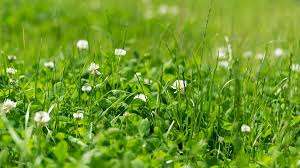Entertainment
Unveiling the Green Marvel: Clover Seed as a Lawn Additive

Welcome to the world of sustainable and lush lawns! Today, we’re diving into a game-changing solution that garden enthusiasts and eco-conscious homeowners are embracing: clover seed as a lawn additive. Forget the endless cycle of watering, fertilizing, and mowing. Let’s explore how integrating clover into your lawn can not only enhance its beauty and resilience but also contribute positively to the environment.
Why Clover?
Clover, particularly white clover (Trifolium repens), has been a traditional lawn component for centuries. In recent years, it has made a comeback for several compelling reasons:
- Drought Tolerance: Clover thrives in conditions where traditional grasses might struggle. It’s naturally drought-resistant, reducing the need for frequent watering.
- Nitrogen Fixation: Clover is a legume with the unique ability to fix atmospheric nitrogen. This natural process fertilizes the lawn, which means less synthetic fertilizer use and a healthier soil ecosystem.
- Low Maintenance: Clover grows quickly and requires less mowing than most grasses. It stays a moderate height, providing a lush, green carpet without constant upkeep.
- Weed Suppression: Its dense growth helps suppress weeds by blocking light to the soil surface, reducing the need for chemical herbicides.
- Pest and Disease Resistance: Clover is resilient against many common lawn pests and diseases, helping to maintain a healthier lawn with fewer chemical interventions.
- Pollinator Friendly: Clover flowers are a source of nectar for bees and other beneficial insects, promoting biodiversity in your garden.
How to Integrate Clover into Your Lawn
Incorporating clover seed into your existing lawn is straightforward and can be done with minimal effort:
- Choosing Your Seed: If you prefer a more uniform look, opt for a micro-clover variety. Micro-clover has smaller leaves and blends seamlessly with most grass species.
- Preparation: Mow your lawn a bit shorter than usual to reduce competition and rake lightly to disturb the soil. This helps the clover seeds make contact with the soil.
- Seeding: Mix clover seeds with sand to help spread them evenly. Use a broadcast spreader or your hand to distribute the seeds over your lawn. Aim for about 2 ounces of clover seed per 1,000 square feet.
- Watering: Keep the seeded area moist until the clover is established. This usually takes about two to three weeks.
- Maintenance: Once established, clover needs minimal care. Mowing should be less frequent, and additional watering is only necessary during prolonged dry spells.
The Impact of Clover on Your Lawn’s Ecosystem
Integrating clover into your lawn does more than just improve its appearance and resilience. It creates a more sustainable and eco-friendly garden space. The addition of clover reduces greenhouse gas emissions from mowing and the manufacturing of fertilizers. It also decreases water usage and provides a habitat for beneficial wildlife, contributing to local ecological health.
Conclusion
Transitioning to a clover-enriched lawn is not just a landscaping choice—it’s a statement of sustainability. It’s about creating a space that is both beautiful and beneficial to the environment. Whether you’re a seasoned gardener or a weekend warrior, consider the humble clover not just as an additive but as a central player in your lawn care strategy. Embrace clover, and watch as your garden transforms into a vibrant, eco-friendly, and low-maintenance haven. Happy gardening!
Entertainment
The Evolution of Online Streaming: Exploring 123movies and Streameast

In an era where digital entertainment reigns supreme, online streaming platforms have revolutionized how we consume media. Everything is just a click away, from blockbuster movies to live sports events. Two of the most talked-about platforms in this landscape, 123movies and Streameast, have attracted millions of users across the globe. Despite being controversial in their operations, their popularity underscores a significant shift in consumer behavior and the growing demand for accessible, on-demand content.
The Rise of Streaming Culture
Over the past decade, traditional television and cable subscriptions have steadily declined. Audiences now prefer the convenience of streaming services, which offer greater control, variety, and affordability. Subscription-based platforms like Netflix, Hulu, and Amazon Prime Video set the standard for legal streaming, but their subscription costs, regional restrictions, and limited catalogs have led many users to explore alternative sources.
That’s where platforms like 123movies and Streameast enter the scene. Though not legal or endorsed by content creators, these sites have garnered immense popularity due to their vast libraries and zero-cost access.
123movies: The Gateway to Free Movie Streaming
123movies is arguably one of the most infamous names in the world of online movie streaming. Originating in Vietnam, the site initially gained notoriety for offering free access to a vast selection of films and TV shows, often before they were available on legal platforms.
Despite being repeatedly taken down and blacklisted by various governments and copyright organizations, 123movies continues to resurface under different domain names and clones. Its interface is user-friendly, allowing viewers to search by genre, year, or IMDb rating, making it appealing for movie buffs on a budget.
Why People Use 123movies
- Free Access: The biggest draw of 123movies is its zero-cost offering. Users can stream the latest releases without paying a dime.
- No Geographic Barriers: Unlike many official platforms, 123movies does not enforce geo-blocking, allowing users worldwide to watch their favorite content.
- Large Library: From indie films to blockbuster hits and complete TV series, the platform hosts a wide array of content.
The Legal and Ethical Gray Area
Despite its appeal, using 123movies is fraught with legal and ethical concerns. Streaming copyrighted content without proper authorization is illegal in many countries. Additionally, such platforms often come loaded with malicious ads, posing security risks to users’ devices.
Internet Service Providers (ISPs) in several regions actively block access to 123movies and similar sites. Nonetheless, the site’s constant reemergence highlights the loopholes in digital enforcement and the persistent demand for free content.
Streameast: A Sports Fan’s Go-To
While 123movies caters primarily to movie and TV show enthusiasts, Streameast has carved a niche for itself in the world of sports streaming. Streameast allows users to watch live broadcasts of events like the NFL, NBA, UFC, soccer matches, and more—all without requiring a paid subscription.
What Makes Streameast So Popular?
- Live Sports Coverage: Fans who can’t afford or access premium sports channels often turn to Streameast for live coverage.
- High-Quality Streams: Streameast offers HD streams that rival official broadcasters, complete with multiple mirror links to ensure availability.
- No Sign-Up Needed: Unlike some streaming services that require registration, Streameast allows instant access to content, enhancing user convenience.
The Downsides of Using Streameast
As with 123movies, Streameast operates in a legally dubious zone. Broadcasting live sports events without the rights to do so violates multiple copyright laws. Furthermore, these platforms are notorious for pop-up ads, tracking cookies, and potential malware risks.
Many sports leagues and broadcasting corporations actively monitor and take legal action against such sites. Still, the temporary availability and accessibility keep users coming back.
The Demand for Alternative Platforms
The popularity of 123movies and Streameast is not solely about piracy—it’s a reflection of deeper issues in the entertainment industry. Rising subscription fees, content fragmentation across platforms, and region-based restrictions make it difficult for users to enjoy a seamless experience.
When a single series requires subscriptions to three different platforms, or a live match is locked behind a costly cable package, users naturally look for alternatives. These platforms, though unofficial and problematic, offer a centralized and free experience that many find hard to resist.
Risks and Considerations
While the convenience of 123movies and Streameast is undeniable, users should be aware of the potential risks:
- Legal Repercussions: In some countries, accessing pirated streams can lead to penalties or legal action.
- Cybersecurity Threats: Many of these sites contain malware, phishing links, and intrusive ads.
- Poor Reliability: Due to takedowns and server overload, these platforms often experience downtime or performance issues.
Safer Legal Alternatives
For those looking to stay on the right side of the law while still enjoying high-quality streaming, here are some alternatives:
- Peacock, Pluto TV, and Tubi: Free ad-supported streaming services that offer a wide range of content.
- ESPN+, DAZN, and FuboTV: Sports-specific platforms for live events, often offering trial periods or lower-cost options.
- Streaming Aggregators: Tools like JustWatch help users find where content is legally available across multiple platforms.
The Future of Streaming: Lessons from 123movies and Streameast
The success of 123movies and Streameast, despite their controversies, sends a clear message to the entertainment industry: viewers crave accessible, affordable, and comprehensive streaming solutions. As more studios launch proprietary platforms and content continues to be fragmented, the risk of users turning to unofficial sources grows.
For the industry to combat piracy effectively, a more consumer-friendly approach is necessary—one that emphasizes affordability, accessibility, and user experience.
Entertainment
Fmovie: The Ultimate Destination for Movie Enthusiasts

In the ever-evolving virtual landscape, online streaming systems have revolutionized the way we watch films. Among the various alternatives available, Fmovie has emerged as a famous choice for cinephiles worldwide. This platform gives a vast collection of movies and TV shows, catering to exceptional tastes and possibilities. Whether you are a fan of Hollywood blockbusters, indie movies, or global cinema, Fmovie affords smooth get right of entry to exquisite content without the want for highly-priced subscriptions.
What is Fmovie?
Fmovie is a free online streaming platform that allows customers to observe their preferred movies and TV shows without any trouble. Unlike conventional streaming offerings like Netflix and Hulu, Fmovie does not require a paid subscription. Instead, it offers a continuing enjoy wherein customers can browse through an in depth library of movies and start streaming instantly.
The platform functions films from various genres, along with motion, thriller, romance, comedy, horror, and technology fiction. It additionally updates its collection frequently, making sure that users have got entry to the latest releases and undying classics alike.
Features of Fmovie
1. Extensive Movie Collection
One of the most attractive functions of Fmovie is its huge choice of movies. Whether you need to observe the modern-day blockbuster or a hidden gem from many years ago, this platform has something for all of us.
2. High-Quality Streaming
Many free streaming websites compromise on video excellence, but Fmovie offers HD streaming, ensuring an enjoyable viewing experience.
3. No Subscription Required
Unlike paid streaming offerings, Fmovie permits users to watch movies without signing up or subscribing. This function makes it an appealing choice for movie enthusiasts who do not want to put money into enjoyment.
4. User-Friendly Interface
The website is designed for smooth navigation, allowing users to look for movies primarily based on genres, release dates, or recognition. This makes finding the precise film effortless.
5. Multi-Device Compatibility
Whether you’re using a laptop, cellphone, or tablet, Fmovie guarantees a continuing streaming experience across more than one device.
Is Fmovie Legal and Safe?
The legality of Fmovie is a gray place. While the platform does no longer host content material itself, it provides links to 0.33-party assets, which may not always be authorized to distribute films. As a end result, gaining access to copyrighted content material through Fmovie would possibly violate prison rules in a few countries.
To make sure safety while using Fmovie, customers are advocated to take precautionary measures which include the use of a VPN, permitting advert-blockers, and heading off suspicious hyperlinks to prevent malware and information breaches
How to Use Fmovie Safely
To beautify your streaming revel in on Fmovie whilst minimizing dangers, follow those safety tips:
Use a VPN: This helps guard your on line identification and ensures privacy.
Enable Ad-Blockers: Free streaming websites regularly have intrusive commercials, which can be averted the usage of an ad-blocker.
Avoid Clicking on Unverified Links: Some pop-america and links may cause malicious sites.
Regularly Update Your Antivirus Software: This helps protect your device from capability threats.
Conclusion
For movie enthusiasts who need to get right of entry to an extensive library without purchasing subscriptions, Fmovie is an attractive option. With its consumer-friendly interface, fantastic streaming, and enormous collection of movies, it gives an extraordinary entertainment enjoyment. However, users have to take into account the felony implications and ability risks related to the usage of loose streaming structures. By following the vital safety measures, you could experience watching your favourite films on Fmovie without compromising protection.
FAQs
1. Is Fmovie unfastened to use?
Yes, Fmovie is a loose streaming platform that permits customers to watch movies and TV shows without a subscription.
2. Is Fmovie prison?
The legality of Fmovie varies with the aid of united states. It affords hyperlinks to third-birthday party sources, which may not always have the rights to distribute content material.
3. How can I get entry to Fmovie thoroughly?
To use Fmovie adequately, consider using a VPN, advert-blockers, and antivirus software program to shield your device from potential threats.
4. Does Fmovie have commercials?
Yes, on account that Fmovie is an unfastened platform, it often presents ads. Using an ad-blocker can help limit interruptions.
5. What are some alternatives to Fmovie?
Some prison alternatives consist of Netflix, Amazon Prime Video, Hulu, Disney , and Tubi.
Entertainment
How to Set Up a Safe and Exciting Backyard Play Area for Kids

A play area in your backyard is a fantastic way to encourage outdoor play, keep kids active, and provide a safe space for fun. Whether you have a large yard or a small outdoor space, you can create an exciting play area in your backyard.
However, creating a safe and interesting backyard play area for kids involves careful planning, materials, and regular maintenance.
In this article, we will give you tips on how to set up an engaging and secure outdoor environment.
Plan the layout
The first step in creating a great play area is choosing a safe location. Select an area that is easily visible from your home to supervise children while they play. Ensure the space is free from obstacles and hazards. Ideally, you want to choose a flat, even ground. This type of ground will prevent tripping and ensure stability for play structures.
Additionally, try to set up a play area in the shade. The shade will keep kids cool and protect them from sun exposure.
Safety features
Before everything, install sturdy fencing around the play area to prevent children from wandering off. Ensure there are no sharp edges or gaps that could pose a risk.
Then, to cover the ground, use soft materials such as rubber mulch, artificial grass, or interlocking play mats to cushion falls. These surfaces are designed to absorb impact better than grass or concrete.
If you’re planning to add different wooden and metal features, make sure you inspect them regularly and check for splinters and rust.
Select the right equipment
When shopping for playground equipment, select suitable items
for your children’s ages and developmental stages. Also, don’t forget to consider their interests when choosing play structures.
Always opt for non-toxic, durable equipment with safety features like rounded corners and secure anchoring to prevent tipping. Look for swings with soft seats and climbing structures with handrails. Ensure everything is installed correctly.
Proper maintenance
To make the toys and play structures last longer, it’s important to regularly maintain them. Keep the play area tidy by removing debris, ensuring that mulch or other ground coverings are replenished as needed, and checking for any hazardous items like sharp objects or toxic plants.
As mentioned, don’t forget to conduct routine checks of all equipment and surfaces for wear and tear. Additionally, to protect toys from weather and to keep your yard clutter-free, keep them in storage bins. Store the bins in your shed with the rest of the numerous garden accessories over the winter.
Backyard play area structure ideas
Now that you know how to safely create a play area in your backyard, here are some of the ideas for play structures your children will love.
- Sensory play areas
If you want something easy and classic for the backyard play area, a sandbox or sensory bin is the way to go. You can never go wrong with these sensory play areas.
These types of areas are crucial for kids’ development. It’s important to opt for interactive and creative play zones that will engage their senses.
Sandboxes, for instance, allow children to dig safely and hygienically in a designated area. Digging, filling, and pouring sand helps develop motor skills, strengthen muscles, and fire the imagination and senses.
Your other options include outdoor chalkboard walls, water play stations, or sensory bins.
- Swing sets and slides
A swing and slide set is a classic addition to any backyard play area. Most kids will enjoy swinging and going down the slide. Plus, having this kind of set in your backyard will save you many trips to the park.
When it comes to the types and sizes of swing and slide sets, you have various options. From small to huge, with slide, without slide, with a playhouse attached to it, and so on.
Assess the size of your space to determine the appropriate swing set dimensions and any additional features it can accommodate. Also, take your children’s age into account. Younger kids will typically enjoy and use a swing set for more years than older ones.
On the other hand, if you don’t find anything appropriate for your backyard, you can always DIY your swing set.
- Climbing adventures
You can encourage your children’s active play with different climbing structures. A climbing wall, for example, can be a great way for kids to expend energy safely. Plus, climbing builds strength and coordination.
In addition to a climbing wall, you can install rock walls and cargo nets, jungle gyms, monkey bars, and so on.
- Backyard sports zone
Let’s not forget about older kids. Your older kids will appreciate you creating a backyard sports zone. You can encourage physical activity and get your kids off the couches with fun sports setups. Depending on what your kids prefer, you can set up a basketball hoop or a pair of goals for soccer. Similarly, you can DIY a mini golf course in your backyard. This is the kind of setup you can enjoy as well.
- Playhouse or a treehouse
Playhouses can encourage creativity and imagination, especially if they include a kitchen area for make-believe cooking and tea parties.
A simple lean-to made of sticks, a fort made from PVC pipe and waterproof canvas, or a reading nook can serve as creative playhouse alternatives.
And if you have a tree in your backyard, you can try building a treehouse. Treehouses can be simple or complex and can include lights. Adding a slide and swings can turn it into an all-in-one playset. A rock wall or cargo net can be used as an alternative to steps for accessing the treehouse.
If you want to DIY your treehouse, simply search the internet to find ideas and plans.
- Cozy reading and relaxation nook
Just like exercise is important for children, so is relaxation. So, don’t forget to create a quiet space for kids to wind down. String a hammock between two trees or add a hanging chair. Both of these options will be perfect for reading.
Your other options include outdoor bean bags, floor cushions, or any other comfortable seating under a shady tree. You can also go a step further and set up a mini teepee or play tent. These will be a perfect cozy hideout for quiet time.
Now that you know all of this, you can create a backyard play area that is both safe and exciting, giving kids a place to explore, imagine, and stay active.
-

 Travel2 years ago
Travel2 years agoNEW ZEALAND VISA FOR ISRAELI AND NORWEGIAN CITIZENS
-

 Technology3 years ago
Technology3 years agoIs Camegle Legit Or A Scam?
-

 Uncategorized2 years ago
Uncategorized2 years agoAMERICAN VISA FOR NORWEGIAN AND JAPANESE CITIZENS
-

 Health2 years ago
Health2 years agoHealth Benefits Of Watermelon
-

 Fashion2 years ago
Fashion2 years agoBest Essentials Hoodies For Cold Weather
-

 Uncategorized3 years ago
Uncategorized3 years agoHow can I write a well-structured blog post?
-

 Technology11 months ago
Technology11 months agoImagine a World Transformed by Technology and Innovation of 2023-1954
-

 Lifestyle2 years ago
Lifestyle2 years agoThese Easy, Affordable Improvements Can Completely Transform Your Home














